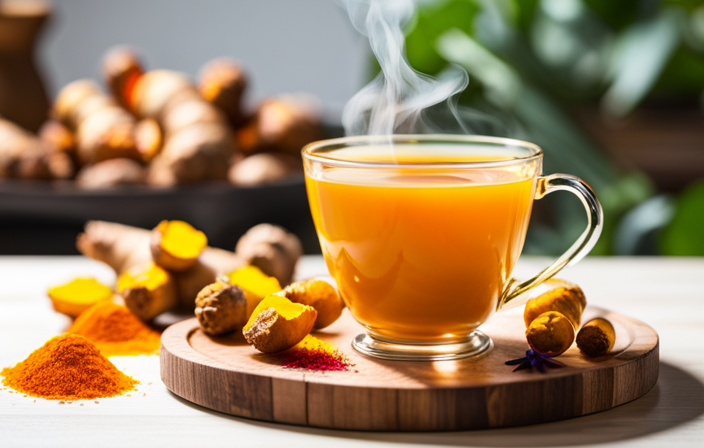Hello tea enthusiasts! I am thrilled to share my special recipe for creating a flavorful and healthy turmeric tea using fresh turmeric root.
Turmeric has been used for centuries in Ayurvedic medicine for its powerful anti-inflammatory and antioxidant properties, and incorporating it into your daily routine can have numerous health benefits.
The process of making turmeric tea is incredibly simple and can be done in just a few easy steps. All you need is fresh turmeric root, water, and your favorite sweetener if desired.
So, let’s gather our ingredients and get started on brewing a warm and comforting cup of turmeric tea that’s not only nutritious but also incredibly tasty.
Key Takeaways
- Fresh turmeric root is the main ingredient needed for making turmeric tea, along with water and a natural sweetener if desired.
- Grating the turmeric root releases the maximum amount of curcumin, while crushing it can extract more of the root’s fiber and nutrients.
- Simmering the tea for 10-15 minutes allows for turmeric’s health benefits to be fully extracted, and straining the tea removes small bits of grated turmeric root and impurities.
- Variations of turmeric tea can include other spices, alternative milks, and herbs, such as cinnamon, ginger, almond milk, and mint, to provide additional health benefits and flavor combinations.
Gather Your Ingredients
Now it’s time for you to gather up your ingredients, so you can make yourself a warm and cozy cup of turmeric tea with fresh turmeric root!
First and foremost, you’ll need fresh turmeric root. You can find it at your local grocery store or health food store. Make sure to choose a root that’s firm and has a bright orange color.
In addition to the fresh turmeric root, you’ll also need water, honey, lemon, and black pepper. These additional ingredients will not only enhance the flavor of your tea but also boost the benefits of turmeric tea.
There are different ways to use fresh turmeric root, but making tea is one of the easiest and most popular methods. So, let’s gather up these ingredients and prepare the turmeric root for your tea.
Prepare the Turmeric Root
Okay, now that we’ve got all the ingredients, let’s get started on preparing the turmeric root.
First, I like to peel off the thin skin to reveal the bright orange flesh underneath.
Then, depending on the recipe, I either grate the root with a fine grater or crush it with a mortar and pestle to release its potent flavor.
It’s important to handle the root carefully since its vibrant color can easily stain clothing and surfaces.
Peel the Root
First, grab a vegetable peeler and remove the skin from the fresh turmeric root, revealing the bright orange flesh inside. Don’t worry if the skin is tough, as it should come off easily with a few strokes of the peeler.
As you peel, you may notice a strong, earthy aroma emanating from the root. This is a sign of the potent antioxidants and anti-inflammatory compounds within the turmeric.
The peelings themselves aren’t typically used in turmeric tea, but don’t throw them away just yet. They can be saved and used for other purposes, such as adding flavor to soups or stews.
As for the fresh turmeric root, it should be stored in the refrigerator to keep it fresh for up to two weeks. Now that the root is peeled, it’s time to move on to the next step: grating or crushing the root to release its beneficial properties.
Grate or Crush the Root
After peeling the skin, you’ll want to grate or crush the bright orange flesh to unlock its powerful properties. Grating and crushing are two common ways of processing fresh turmeric root, and each method has its own advantages and drawbacks.
Grating the root is a popular choice because it produces a fine, powdery texture that can easily dissolve in hot water. This method also helps to release the maximum amount of curcumin, the active ingredient in turmeric, which is known for its anti-inflammatory and antioxidant properties.
On the other hand, crushing the root can be more time-consuming and messy, but it may be a better option if you want to extract more of the root’s fiber and nutrients. Additionally, you can use fresh turmeric in other recipes by adding grated or crushed turmeric to smoothies, soups, or stir-fries for a boost of flavor and health benefits.
Now that you’ve grated or crushed the turmeric root, it’s time to brew the tea.
Brew the Tea
So now that I’ve prepared the turmeric root, it’s time to brew the tea.
First, I’ll boil some water in a pot. Then, I’ll add the fresh turmeric root to the boiling water and let it simmer for about 10-15 minutes.
This’ll allow the flavors and nutrients to infuse into the water, creating a delicious and healthy tea.
Boil the Water
To start making turmeric tea, simply bring your water to a boil. I prefer to use filtered water for the best taste. Once the water’s boiling, turn off the heat and let it cool for a minute or two before pouring it into your teapot or mug.
Benefits of drinking turmeric tea:
- Turmeric’s anti-inflammatory properties can help reduce joint pain and swelling.
- It’s a natural immune booster and has been shown to improve brain function and reduce the risk of heart disease.
Different ways to sweeten turmeric tea:
- Honey is a popular option that also provides additional health benefits.
- You can also use maple syrup or stevia as a natural sweetener.
Now that the water’s ready, it’s time to add the turmeric root.
Add the Turmeric Root
Now, you can enhance the flavor and reap the health benefits of turmeric by adding a small piece of the vibrant yellow root to your hot water. Turmeric root is a natural anti-inflammatory and antioxidant powerhouse, making it a great addition to your daily routine.
It has been used for centuries in Ayurvedic medicine to treat a variety of ailments, from digestive issues to arthritis. There are different ways to use turmeric root in recipes, but for this tea, simply peel a small piece of the root and grate it into your boiling water. You can also slice it thinly or use a mortar and pestle to grind it into a powder.
The amount you use will depend on your preference, but a thumb-sized piece is a good place to start. Once you’ve added the turmeric, let it simmer for 10-15 minutes to allow the flavors to infuse.
Simmer for 10-15 Minutes
Now that the turmeric root’s in the pot, it’s time to let it simmer for 10-15 minutes. This’ll allow flavors to infuse into the water and create a deliciously fragrant tea. As the water heats up, you’ll notice the vibrant orange color of the turmeric root seep into the liquid.
Simmering the tea for this amount of time’ll allow for turmeric’s health benefits to be fully extracted. Turmeric has anti-inflammatory properties and may even help with digestion. Additionally, the simmering process brings out the natural sweetness of the turmeric root, creating a well-balanced flavor profile for the tea.
Once the tea has simmered, it’s time to move on to the next step: strain and serve.
Strain and Serve
Once the tea has steeped for 10-15 minutes, it’s time to strain and serve your turmeric tea. Straining the tea will remove the small bits of grated turmeric root and any other impurities that might have found their way into the tea. You can use a fine mesh strainer, cheesecloth, or a tea filter to strain your tea.
Hold the strainer over your cup or teapot and pour the tea through the strainer. You may need to press the turmeric pulp with a spoon to get all the liquid through the strainer.
Now that your tea is perfectly strained, you can serve it hot or cold, depending on your preference. If you’re serving it hot, add a sweetener of your choice, such as honey or maple syrup, to balance out the bitterness of the turmeric. You can also add a squeeze of lemon or orange juice for a citrusy kick.
If you prefer your tea cold, let it cool to room temperature and then refrigerate it. Serve it over ice with a slice of lemon or cucumber.
Moving on to tips and variations, there are many ways to customize your turmeric tea. You can experiment with adding different spices such as cinnamon or ginger, or try using different types of milk such as almond or coconut milk. You can also add other herbs such as mint or chamomile for added health benefits and flavor. The possibilities are endless, so have fun exploring and creating your own unique turmeric tea recipe.
Tips and Variations
To add some extra flair to your turmeric beverage, you can try experimenting with different spices like cinnamon or ginger, and using alternative milks such as almond or coconut milk. These flavor combinations not only enhance the taste of the tea, but also provide additional health benefits.
Here are some ideas to get you started:
-
Cinnamon and honey: Add a teaspoon of cinnamon and a drizzle of honey to your turmeric tea for a sweet and spicy treat that may help lower blood sugar levels.
-
Ginger and lemon: Grate some fresh ginger and squeeze in some lemon juice for a refreshing and immune-boosting drink.
-
Cardamom and vanilla: Add a pinch of cardamom and a splash of vanilla extract for a fragrant and comforting cup of tea that may help improve digestion.
-
Black pepper and coconut milk: Sprinkle in some black pepper and stir in some coconut milk for a creamy and antioxidant-rich beverage that may help fight inflammation.
Not only are these flavor combinations delicious, but they also provide a variety of health benefits. From improving brain function to reducing inflammation, turmeric tea with added spices and alternative milks is a tasty way to boost your overall wellness.
Frequently Asked Questions
How much turmeric should I use to make a cup of turmeric tea?
When making turmeric tea, the ideal ratio is one teaspoon of grated or ground turmeric to one cup of water. However, variations in recipe may call for more or less depending on personal preference.
Can I use ground turmeric instead of fresh turmeric root?
Using ground turmeric instead of fresh turmeric root can be like using powdered garlic instead of fresh garlic. While it may be convenient, the health benefits of turmeric supplements are not as potent as using fresh turmeric in cooking.
Is it safe to consume turmeric tea every day?
Yes, it is generally safe to consume turmeric tea every day. Turmeric tea benefits include its anti-inflammatory and antioxidant properties. However, excessive consumption may lead to potential side effects, such as stomach upset or blood thinning.
How long can I store leftover turmeric tea in the refrigerator?
I know it may seem wasteful to throw away leftover turmeric tea, but fear not! You can reuse it in smoothies or as a toner for your skin. The benefits of turmeric for skin when consumed internally are numerous, so don’t let any go to waste. As for storage, leftover turmeric tea can be stored in the refrigerator for up to 5 days.
Can I add honey or other sweeteners to my turmeric tea?
Yes, I can add honey or other sweeteners to my turmeric tea. While turmeric alone has health benefits, adding natural sweeteners can enhance the flavor and provide additional health benefits, such as improving digestion and boosting the immune system.
Conclusion
Well, there you have it, folks! Here’s a simple recipe on how to make turmeric tea with fresh turmeric root. Not only is this tea delicious and refreshing, but it also has numerous health benefits.
In fact, a study published in the Journal of Medicinal Food found that consuming turmeric can help improve cognitive function and reduce inflammation. One interesting statistic to note is that turmeric has been used for centuries in Ayurvedic medicine and traditional Chinese medicine to treat a variety of ailments, including digestive issues, joint pain, and skin problems.
With its anti-inflammatory and antioxidant properties, it’s no wonder that turmeric has become increasingly popular in Western medicine as well. So, next time you’re looking for a healthy and tasty beverage, give this turmeric tea recipe a try!










